Friday, February 6th 2015
DeepCool Announces GamerStorm Assassin II CPU Cooler
DeepCool rolled out the second generation of its GamerStorm Assassin type-D twin-stack CPU cooler. The Assassin II is huge, measuring in at 143 mm x 158 mm x 167 mm (WxDxH), weighing 1.48 kg (including fans). Its design consists of a large nickel-plated copper base, from which eight nicke-plated copper heat pipes pass through, conveying heat to two aluminium fin stacks. The two stacks are not of the same shape.
One of the two fin stacks features an edge that's pointing towards the rear of your case, and hence you can't strap three fans onto this heatsink, just a push fan, and a conveyor between the two fin-stacks, but not a pull fan. The push fan is a 120 mm spinner, running between 300 and 1,400 RPM, pushing up to 68.06 CFM of air, with a noise output ranging between 17.8 to 27.3 dBA. The conveyor fan is a 140 mm spinner, clocking 300 to 1,200 RPM, pushing up to 70.08 CFM of air, with a noise output ranging between 17.8 and 27.3 dBA. The Assassin II can handle all modern CPU socket types, including LGA2011v3, LGA1150, AM3+, and FM2+. DeepCool didn't mention if the cooler is good enough for 220W TDP chips such as the AMD FX-9000 series.
One of the two fin stacks features an edge that's pointing towards the rear of your case, and hence you can't strap three fans onto this heatsink, just a push fan, and a conveyor between the two fin-stacks, but not a pull fan. The push fan is a 120 mm spinner, running between 300 and 1,400 RPM, pushing up to 68.06 CFM of air, with a noise output ranging between 17.8 to 27.3 dBA. The conveyor fan is a 140 mm spinner, clocking 300 to 1,200 RPM, pushing up to 70.08 CFM of air, with a noise output ranging between 17.8 and 27.3 dBA. The Assassin II can handle all modern CPU socket types, including LGA2011v3, LGA1150, AM3+, and FM2+. DeepCool didn't mention if the cooler is good enough for 220W TDP chips such as the AMD FX-9000 series.
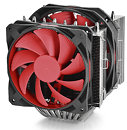
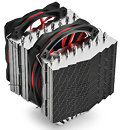
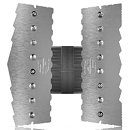
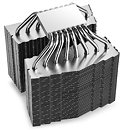
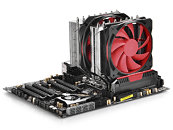
32 Comments on DeepCool Announces GamerStorm Assassin II CPU Cooler
they probably just use Intel throttle temps and call it a day.
300w+:eek:we better call MSI and have them get the nitrogen ready.
source: AMD FX Performance Tuning Guide
we all know Devils Canyon is up to 5ghz on air too and neither pull the kind of wattage cpu air cooler companies put on a box.
edit-would def like to know if I am missing something
:laugh::laugh::laugh::laugh::laugh::laugh::laugh::laugh:
As far as HSF or liquid cooler performance, it's best to use reputable online sources such as Frosty Tech, Hardware Secrets, etc. who actually know how to properly test a HSF/liquid cooler and do so. There are many variables with CPU coolers and if these are not controlled in a test, the data is meaningless. CPU cooler companies may or may not be properly reporting the real world cooling performance of their coolers.
There are numerous top of the line tower HSFs that will properly cool an FX-9590 or any other X86 style CPU. Below is an example of some of the "top 5+" HSFs that have actually been used with excellent result on the FX-9xxx series CPUs. I have personally conducted extensive, as in 20+ hour Prime 95 stress tests on the FX-8xxx series CPUs OC'd to 4.7 Ghz. (the base clock of the FX-9590), with the Xigmatek Aegir SD128264 HSF and it keeps the CPU under 61C as AMD specifies - even in these marathon P95 torture tests.
www.frostytech.com/articleview.cfm?articleid=2572&page=4
Don't be duped into believing AIO/CLC liquid coolers are better. Do your homework so you know exactly what you are getting. People often do not understand just how inferior these CLC/AIO liquid coolers are until they see the cooler performance data. The Corsair H60 is a perfect example and a popular mistake that many people purchase. There are over a hundred better performing HSFs than the H60 liquid cooler and many costs less than the H60 and never leak coolant to damage your PC. In addition to the inferior performance of the H60 compared to a 100+ HSFs, there are serious reliability issues with these coolers. Check the Corsair website for the sad tales of woe from those who have purchased these coolers and had multiple failures.
www.frostytech.com/articleview.cfm?articleid=2705&page=5
BTW, this new Assassin II is probably a great cooler but larger than it probably needs to be. It would be nice to know exactly how large a fin area is really effective. This takes a lot of carefully controlled testing to determine but it is worth the effort, IMO.
4.7ghz is not 5ghz and your vcore is probably lower than the 9590 out of box
you linked tests for 125w
its 62c for safe daily temp for good lifespan and up to 70c according to overdrive
5ghz can be stable on air with the best of the best case fans and heatsinks but is AMD just going to trust everyone and not issue a recommendation.. yeah that would be dumb if they didnt
is what it is I guess.. wasnt trying to start a fiasco but if that is all there is to be said then most tdp ratings are garage..
where did you ever get 300+ from anyway? dont bother I guess..
Typical BS from an airhead fanboy.
there is also that with air coolers your relying on case fans to pull the hot air out of the case.
I dont think there is really any denying that air cooling is not what you want for high overclocks and high tdp.
with gpu's your talking dramatic differences if you switch out a air cooler for a block or even a cheaper aio.
my point was really just that high tdp ratings make no since.. Intel has lower tdp for 5ghz yet that is all that can happen with air cooling.
And yeah, you can pretty much max out many CPUs using air cooling. That is, if the thermal interface is not utterly horrible.
www.overclock.net/t/224941/nols-bong-guide
I don't think it's that hard to build o_O
guess your right seeing as how some motherboards are made an even incorporate using a ln2 pot.
Having this discussions feels like having a discussion about whether is helium really lighter than air or not. It's inarguable. Using Chemical reactions to actions (the bong) is not what we're talking about here.